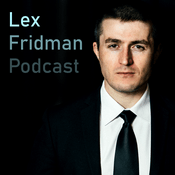243 episodios

Bayesian Brain, Scientific Method, and Models [Dr. Jeff Beck]
31/12/2025 | 1 h 16 min
Dr. Jeff Beck, mathematician turned computational neuroscientist, joins us for a fascinating deep dive into why the future of AI might look less like ChatGPT and more like your own brain.**SPONSOR MESSAGES START**—Prolific - Quality data. From real people. For faster breakthroughs.https://www.prolific.com/?utm_source=mlst—**END***What if the key to building truly intelligent machines isn't bigger models, but smarter ones?*In this conversation, Jeff makes a compelling case that we've been building AI backwards. While the tech industry races to scale up transformers and language models, Jeff argues we're missing something fundamental: the brain doesn't work like a giant prediction engine. It works like a scientist, constantly testing hypotheses about a world made of *objects* that interact through *forces* — not pixels and tokens.*The Bayesian Brain* — Jeff explains how your brain is essentially running the scientific method on autopilot. When you combine what you see with what you hear, you're doing optimal Bayesian inference without even knowing it. This isn't just philosophy — it's backed by decades of behavioral experiments showing humans are surprisingly efficient at handling uncertainty.*AutoGrad Changed Everything* — Forget transformers for a moment. Jeff argues the real hero of the AI boom was automatic differentiation, which turned AI from a math problem into an engineering problem. But in the process, we lost sight of what actually makes intelligence work.*The Cat in the Warehouse Problem* — Here's where it gets practical. Imagine a warehouse robot that's never seen a cat. Current AI would either crash or make something up. Jeff's approach? Build models that *know what they don't know*, can phone a friend to download new object models on the fly, and keep learning continuously. It's like giving robots the ability to say "wait, what IS that?" instead of confidently being wrong.*Why Language is a Terrible Model for Thought* — In a provocative twist, Jeff argues that grounding AI in language (like we do with LLMs) is fundamentally misguided. Self-report is the least reliable data in psychology — people routinely explain their own behavior incorrectly. We should be grounding AI in physics, not words.*The Future is Lots of Little Models* — Instead of one massive neural network, Jeff envisions AI systems built like video game engines: thousands of small, modular object models that can be combined, swapped, and updated independently. It's more efficient, more flexible, and much closer to how we actually think.Rescript: https://app.rescript.info/public/share/D-b494t8DIV-KRGYONJghvg-aelMmxSDjKthjGdYqsE---TIMESTAMPS:00:00:00 Introduction & The Bayesian Brain00:01:25 Bayesian Inference & Information Processing00:05:17 The Brain Metaphor: From Levers to Computers00:10:13 Micro vs. Macro Causation & Instrumentalism00:16:59 The Active Inference Community & AutoGrad00:22:54 Object-Centered Models & The Grounding Problem00:35:50 Scaling Bayesian Inference & Architecture Design00:48:05 The Cat in the Warehouse: Solving Generalization00:58:17 Alignment via Belief Exchange01:05:24 Deception, Emergence & Cellular Automata---REFERENCES:Paper:[00:00:24] Zoubin Ghahramani (Google DeepMind)https://pmc.ncbi.nlm.nih.gov/articles/PMC3538441/pdf/rsta201[00:19:20] Mamba: Linear-Time Sequence Modelinghttps://arxiv.org/abs/2312.00752[00:27:36] xLSTM: Extended Long Short-Term Memoryhttps://arxiv.org/abs/2405.04517[00:41:12] 3D Gaussian Splattinghttps://repo-sam.inria.fr/fungraph/3d-gaussian-splatting/[01:07:09] Lenia: Biology of Artificial Lifehttps://arxiv.org/abs/1812.05433[01:08:20] Growing Neural Cellular Automatahttps://distill.pub/2020/growing-ca/[01:14:05] DreamCoderhttps://arxiv.org/abs/2006.08381[01:14:58] The Genomic Bottleneckhttps://www.nature.com/articles/s41467-019-11786-6Person:[00:16:42] Karl Friston (UCL)https://www.youtube.com/watch?v=PNYWi996Beg

Your Brain is Running a Simulation Right Now [Max Bennett]
30/12/2025 | 3 h 17 min
Tim sits down with Max Bennett to explore how our brains evolved over 600 million years—and what that means for understanding both human intelligence and AI.Max isn't a neuroscientist by training. He's a tech entrepreneur who got curious, started reading, and ended up weaving together three fields that rarely talk to each other: comparative psychology (what different animals can actually do), evolutionary neuroscience (how brains changed over time), and AI (what actually works in practice).*Your Brain Is a Guessing Machine*You don't actually "see" the world. Your brain builds a simulation of what it *thinks* is out there and just uses your eyes to check if it's right. That's why optical illusions work—your brain is filling in a triangle that isn't there, or can't decide if it's looking at a duck or a rabbit.*Rats Have Regrets**Chimps Are Machiavellian**Language Is the Human Superpower**Does ChatGPT Think?*(truncated description, more on rescript)Understanding how the brain evolved isn't just about the past. It gives us clues about:- What's actually different between human intelligence and AI- Why we're so easily fooled by status games and tribal thinking- What features we might want to build into—or leave out of—future AI systemsGet Max's book:https://www.amazon.com/Brief-History-Intelligence-Humans-Breakthroughs/dp/0063286343Rescript: https://app.rescript.info/public/share/R234b7AXyDXZusqQ_43KMGsUSvJ2TpSz2I3emnI6j9A---TIMESTAMPS:00:00:00 Introduction: Outsider's Advantage & Neocortex Theories00:11:34 Perception as Inference: The Filling-In Machine00:19:11 Understanding, Recognition & Generative Models00:36:39 How Mice Plan: Vicarious Trial & Error00:46:15 Evolution of Self: The Layer 4 Mystery00:58:31 Ancient Minds & The Social Brain: Machiavellian Apes01:19:36 AI Alignment, Instrumental Convergence & Status Games01:33:07 Metacognition & The IQ Paradox01:48:40 Does GPT Have Theory of Mind?02:00:40 Memes, Language Singularity & Brain Size Myths02:16:44 Communication, Language & The Cyborg Future02:44:25 Shared Fictions, World Models & The Reality Gap---REFERENCES:Person:[00:00:05] Karl Friston (UCL)https://www.youtube.com/watch?v=PNYWi996Beg[00:00:06] Jeff Hawkinshttps://www.youtube.com/watch?v=6VQILbDqaI4[00:12:19] Hermann von Helmholtzhttps://plato.stanford.edu/entries/hermann-helmholtz/[00:38:34] David Redish (U. Minnesota)https://redishlab.umn.edu/[01:10:19] Robin Dunbarhttps://www.psy.ox.ac.uk/people/robin-dunbar[01:15:04] Emil Menzelhttps://www.sciencedirect.com/bookseries/behavior-of-nonhuman-primates/vol/5/suppl/C[01:19:49] Nick Bostromhttps://nickbostrom.com/[02:28:25] Noam Chomskyhttps://linguistics.mit.edu/user/chomsky/[03:01:22] Judea Pearlhttps://samueli.ucla.edu/people/judea-pearl/Concept/Framework:[00:05:04] Active Inferencehttps://www.youtube.com/watch?v=KkR24ieh5OwPaper:[00:35:59] Predictions not commands [Rick A Adams]https://pubmed.ncbi.nlm.nih.gov/23129312/Book:[01:25:42] The Elephant in the Brainhttps://www.amazon.com/Elephant-Brain-Hidden-Motives-Everyday/dp/0190495995[01:28:27] The Status Gamehttps://www.goodreads.com/book/show/58642436-the-status-game[02:00:40] The Selfish Genehttps://amazon.com/dp/0198788606[02:14:25] The Language Gamehttps://www.amazon.com/Language-Game-Improvisation-Created-Changed/dp/1541674987[02:54:40] The Evolution of Languagehttps://www.amazon.com/Evolution-Language-Approaches/dp/052167736X[03:09:37] The Three-Body Problemhttps://amazon.com/dp/0765377063

The 3 Laws of Knowledge [César Hidalgo]
27/12/2025 | 1 h 37 min
César Hidalgo has spent years trying to answer a deceptively simple question: What is knowledge, and why is it so hard to move around?We all have this intuition that knowledge is just... information. Write it down in a book, upload it to GitHub, train an AI on it—done. But César argues that's completely wrong. Knowledge isn't a thing you can copy and paste. It's more like a living organism that needs the right environment, the right people, and constant exercise to survive.Guest: César Hidalgo, Director of the Center for Collective Learning1. Knowledge Follows Laws (Like Physics)2. You Can't Download Expertise3. Why Big Companies Fail to Adapt4. The "Infinite Alphabet" of EconomiesIf you think AI can just "copy" human knowledge, or that development is just about throwing money at poor countries, or that writing things down preserves them forever—this conversation will change your mind. Knowledge is fragile, specific, and collective. It decays fast if you don't use it. The Infinite Alphabet [César A. Hidalgo]https://www.penguin.co.uk/books/458054/the-infinite-alphabet-by-hidalgo-cesar-a/9780241655672https://x.com/cesifotiRescript link. https://app.rescript.info/public/share/eaBHbEo9xamwbwpxzcVVm4NQjMh7lsOQKeWwNxmw0JQ---TIMESTAMPS:00:00:00 The Three Laws of Knowledge00:02:28 Rival vs. Non-Rival: The Economics of Ideas00:05:43 Why You Can't Just 'Download' Knowledge00:08:11 The Detective Novel Analogy00:11:54 Collective Learning & Organizational Networks00:16:27 Architectural Innovation: Amazon vs. Barnes & Noble00:19:15 The First Law: Learning Curves00:23:05 The Samuel Slater Story: Treason & Memory00:28:31 Physics of Knowledge: Joule's Cannon00:32:33 Extensive vs. Intensive Properties00:35:45 Knowledge Decay: Ise Temple & Polaroid00:41:20 Absorptive Capacity: Sony & Donetsk00:47:08 Disruptive Innovation & S-Curves00:51:23 Team Size & The Cost of Innovation00:57:13 Geography of Knowledge: Vespa's Origin01:04:34 Migration, Diversity & 'Planet China'01:12:02 Institutions vs. Knowledge: The China Story01:21:27 Economic Complexity & The Infinite Alphabet01:32:27 Do LLMs Have Knowledge?---REFERENCES:Book:[00:47:45] The Innovator's Dilemma (Christensen)https://www.amazon.com/Innovators-Dilemma-Revolutionary-Change-Business/dp/0062060244[00:55:15] Why Greatness Cannot Be Plannedhttps://amazon.com/dp/3319155237[01:35:00] Why Information Growshttps://amazon.com/dp/0465048994Paper:[00:03:15] Endogenous Technological Change (Romer, 1990)https://web.stanford.edu/~klenow/Romer_1990.pdf[00:03:30] A Model of Growth Through Creative Destruction (Aghion & Howitt, 1992)https://dash.harvard.edu/server/api/core/bitstreams/7312037d-2b2d-6bd4-e053-0100007fdf3b/content[00:14:55] Organizational Learning: From Experience to Knowledge (Argote & Miron-Spektor, 2011)https://www.researchgate.net/publication/228754233_Organizational_Learning_From_Experience_to_Knowledge[00:17:05] Architectural Innovation (Henderson & Clark, 1990)https://www.researchgate.net/publication/200465578_Architectural_Innovation_The_Reconfiguration_of_Existing_Product_Technologies_and_the_Failure_of_Established_Firms[00:19:45] The Learning Curve Equation (Thurstone, 1916)https://dn790007.ca.archive.org/0/items/learningcurveequ00thurrich/learningcurveequ00thurrich.pdf[00:21:30] Factors Affecting the Cost of Airplanes (Wright, 1936)https://pdodds.w3.uvm.edu/research/papers/others/1936/wright1936a.pdf[00:52:45] Are Ideas Getting Harder to Find? (Bloom et al.)https://web.stanford.edu/~chadj/IdeaPF.pdf[01:33:00] LLMs/ Emergencehttps://arxiv.org/abs/2506.11135Person:[00:25:30] Samuel Slaterhttps://en.wikipedia.org/wiki/Samuel_Slater[00:42:05] Masaru Ibuka (Sony)https://www.sony.com/en/SonyInfo/CorporateInfo/History/SonyHistory/1-02.html

"I Desperately Want To Live In The Matrix" - Dr. Mike Israetel
24/12/2025 | 2 h 55 min
This is a lively, no-holds-barred debate about whether AI can truly be intelligent, conscious, or understand anything at all — and what happens when (or if) machines become smarter than us.Dr. Mike Israetel is a sports scientist, entrepreneur, and co-founder of RP Strength (a fitness company). He describes himself as a "dilettante" in AI but brings a fascinating outsider's perspective.Jared Feather (IFBB Pro bodybuilder and exercise physiologist)The Big Questions:1. When is superintelligence coming?2. Does AI actually understand anything?3. The Simulation Debate (The Spiciest Part)4. Will AI kill us all? (The Doomer Debate)5. What happens to human jobs and purpose?6. Do we need suffering?Mikes channel: https://www.youtube.com/channel/UCfQgsKhHjSyRLOp9mnffqVgRESCRIPT INTERACTIVE PLAYER: https://app.rescript.info/public/share/GVMUXHCqctPkXH8WcYtufFG7FQcdJew_RL_MLgMKU1U---TIMESTAMPS:00:00:00 Introduction & Workout Demo00:04:15 ASI Timelines & Definitions00:10:24 The Embodiment Debate00:18:28 Neutrinos & Abstract Knowledge00:25:56 Can AI Learn From YouTube?00:31:25 Diversity of Intelligence00:36:00 AI Slop & Understanding00:45:18 The Simulation Argument: Fire & Water00:58:36 Consciousness & Zombies01:04:30 Do Reasoning Models Actually Reason?01:12:00 The Live Learning Problem01:19:15 Superintelligence & Benevolence01:28:59 What is True Agency?01:37:20 Game Theory & The "Kill All Humans" Fallacy01:48:05 Regulation & The China Factor01:55:52 Mind Uploading & The Future of Love02:04:41 Economics of ASI: Will We Be Useless?02:13:35 The Matrix & The Value of Suffering02:17:30 Transhumanism & Inequality02:21:28 Debrief: AI Medical Advice & Final Thoughts---REFERENCES:Paper:[00:10:45] Alchemy and Artificial Intelligence (Dreyfus)https://www.rand.org/content/dam/rand/pubs/papers/2006/P3244.pdf[00:10:55] The Chinese Room Argument (John Searle)https://home.csulb.edu/~cwallis/382/readings/482/searle.minds.brains.programs.bbs.1980.pdf[00:11:05] The Symbol Grounding Problem (Stephen Harnad)https://arxiv.org/html/cs/9906002[00:23:00] Attention Is All You Needhttps://arxiv.org/abs/1706.03762[00:45:00] GPT-4 Technical Reporthttps://arxiv.org/abs/2303.08774[01:45:00] Anthropic Agentic Misalignment Paperhttps://www.anthropic.com/research/agentic-misalignment[02:17:45] Retatrutidehttps://pubmed.ncbi.nlm.nih.gov/37366315/Organization:[00:15:50] CERNhttps://home.cern/[01:05:00] METR Long Horizon Evaluationshttps://evaluations.metr.org/MLST Episode:[00:23:10] MLST: Llion Jones - Inventors' Remorsehttps://www.youtube.com/watch?v=DtePicx_kFY[00:50:30] MLST: Blaise Agüera y Arcas Interviewhttps://www.youtube.com/watch?v=rMSEqJ_4EBk[01:10:00] MLST: David Krakauerhttps://www.youtube.com/watch?v=dY46YsGWMIcEvent:[00:23:40] ARC Prize/Challengehttps://arcprize.org/Book:[00:24:45] The Brain Abstractedhttps://www.amazon.com/Brain-Abstracted-Simplification-Philosophy-Neuroscience/dp/0262548046[00:47:55] Pamela McCorduckhttps://www.amazon.com/Machines-Who-Think-Artificial-Intelligence/dp/1568812051[01:23:15] The Singularity Is Nearer (Ray Kurzweil)https://www.amazon.com/Singularity-Nearer-Ray-Kurzweil-ebook/dp/B08Y6FYJVY[01:27:35] A Fire Upon The Deep (Vernor Vinge)https://www.amazon.com/Fire-Upon-Deep-S-F-MASTERWORKS-ebook/dp/B00AVUMIZE/[02:04:50] Deep Utopia (Nick Bostrom)https://www.amazon.com/Deep-Utopia-Meaning-Solved-World/dp/1646871642[02:05:00] Technofeudalism (Yanis Varoufakis)https://www.amazon.com/Technofeudalism-Killed-Capitalism-Yanis-Varoufakis/dp/1685891241Visual Context Needed:[00:29:40] AT-AT Walker (Star Wars)https://starwars.fandom.com/wiki/All_Terrain_Armored_TransportPerson:[00:33:15] Andrej Karpathyhttps://karpathy.ai/Video:[01:40:00] Mike Israetel vs Liron Shapira AI Doom Debatehttps://www.youtube.com/watch?v=RaDWSPMdM4oCompany:[02:26:30] Examine.comhttps://examine.com/

Making deep learning perform real algorithms with Category Theory (Andrew Dudzik, Petar Velichkovich, Taco Cohen, Bruno Gavranović, Paul Lessard)
22/12/2025 | 43 min
We often think of Large Language Models (LLMs) as all-knowing, but as the team reveals, they still struggle with the logic of a second-grader. Why can’t ChatGPT reliably add large numbers? Why does it "hallucinate" the laws of physics? The answer lies in the architecture. This episode explores how *Category Theory* —an ultra-abstract branch of mathematics—could provide the "Periodic Table" for neural networks, turning the "alchemy" of modern AI into a rigorous science.In this deep-dive exploration, *Andrew Dudzik*, *Petar Velichkovich*, *Taco Cohen*, *Bruno Gavranović*, and *Paul Lessard* join host *Tim Scarfe* to discuss the fundamental limitations of today’s AI and the radical mathematical framework that might fix them.TRANSCRIPT:https://app.rescript.info/public/share/LMreunA-BUpgP-2AkuEvxA7BAFuA-VJNAp2Ut4MkMWk---Key Insights in This Episode:* *The "Addition" Problem:* *Andrew Dudzik* explains why LLMs don't actually "know" math—they just recognize patterns. When you change a single digit in a long string of numbers, the pattern breaks because the model lacks the internal "machinery" to perform a simple carry operation.* *Beyond Alchemy:* deep learning is currently in its "alchemy" phase—we have powerful results, but we lack a unifying theory. Category Theory is proposed as the framework to move AI from trial-and-error to principled engineering. [00:13:49]* *Algebra with Colors:* To make Category Theory accessible, the guests use brilliant analogies—like thinking of matrices as *magnets with colors* that only snap together when the types match. This "partial compositionality" is the secret to building more complex internal reasoning. [00:09:17]* *Synthetic vs. Analytic Math:* *Paul Lessard* breaks down the philosophical shift needed in AI research: moving from "Analytic" math (what things are made of) to "Synthetic" math [00:23:41]---Why This Matters for AGIIf we want AI to solve the world's hardest scientific problems, it can't just be a "stochastic parrot." It needs to internalize the rules of logic and computation. By imbuing neural networks with categorical priors, researchers are attempting to build a future where AI doesn't just predict the next word—it understands the underlying structure of the universe.---TIMESTAMPS:00:00:00 The Failure of LLM Addition & Physics00:01:26 Tool Use vs Intrinsic Model Quality00:03:07 Efficiency Gains via Internalization00:04:28 Geometric Deep Learning & Equivariance00:07:05 Limitations of Group Theory00:09:17 Category Theory: Algebra with Colors00:11:25 The Systematic Guide of Lego-like Math00:13:49 The Alchemy Analogy & Unifying Theory00:15:33 Information Destruction & Reasoning00:18:00 Pathfinding & Monoids in Computation00:20:15 System 2 Reasoning & Error Awareness00:23:31 Analytic vs Synthetic Mathematics00:25:52 Morphisms & Weight Tying Basics00:26:48 2-Categories & Weight Sharing Theory00:28:55 Higher Categories & Emergence00:31:41 Compositionality & Recursive Folds00:34:05 Syntax vs Semantics in Network Design00:36:14 Homomorphisms & Multi-Sorted Syntax00:39:30 The Carrying Problem & Hopf FibrationsPetar Veličković (GDM)https://petar-v.com/Paul Lessardhttps://www.linkedin.com/in/paul-roy-lessard/Bruno Gavranovićhttps://www.brunogavranovic.com/Andrew Dudzik (GDM)https://www.linkedin.com/in/andrew-dudzik-222789142/---REFERENCES:Model:[00:01:05] Veohttps://deepmind.google/models/veo/[00:01:10] Geniehttps://deepmind.google/blog/genie-3-a-new-frontier-for-world-models/Paper:[00:04:30] Geometric Deep Learning Blueprinthttps://arxiv.org/abs/2104.13478https://www.youtube.com/watch?v=bIZB1hIJ4u8[00:16:45] AlphaGeometryhttps://arxiv.org/abs/2401.08312[00:16:55] AlphaCodehttps://arxiv.org/abs/2203.07814[00:17:05] FunSearchhttps://www.nature.com/articles/s41586-023-06924-6[00:37:00] Attention Is All You Needhttps://arxiv.org/abs/1706.03762[00:43:00] Categorical Deep Learninghttps://arxiv.org/abs/2402.15332
Más podcasts de Tecnología
Podcasts a la moda de Tecnología
Acerca de Machine Learning Street Talk (MLST)
Escucha Machine Learning Street Talk (MLST), All-In with Chamath, Jason, Sacks & Friedberg y muchos más podcasts de todo el mundo con la aplicación de radio.net

Descarga la app gratuita: radio.net
- Añadir radios y podcasts a favoritos
- Transmisión por Wi-Fi y Bluetooth
- Carplay & Android Auto compatible
- Muchas otras funciones de la app
Descarga la app gratuita: radio.net
- Añadir radios y podcasts a favoritos
- Transmisión por Wi-Fi y Bluetooth
- Carplay & Android Auto compatible
- Muchas otras funciones de la app


Machine Learning Street Talk (MLST)
Descarga la app,
Escucha.



























